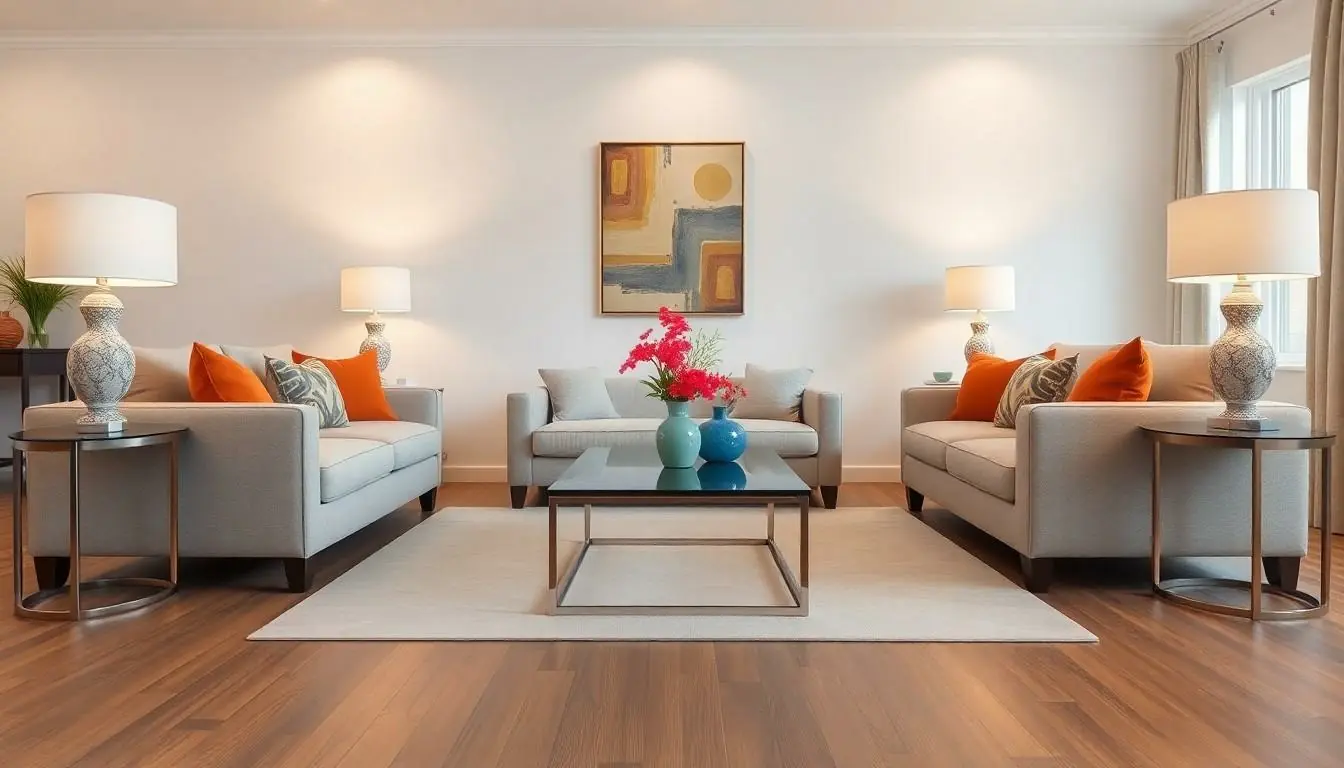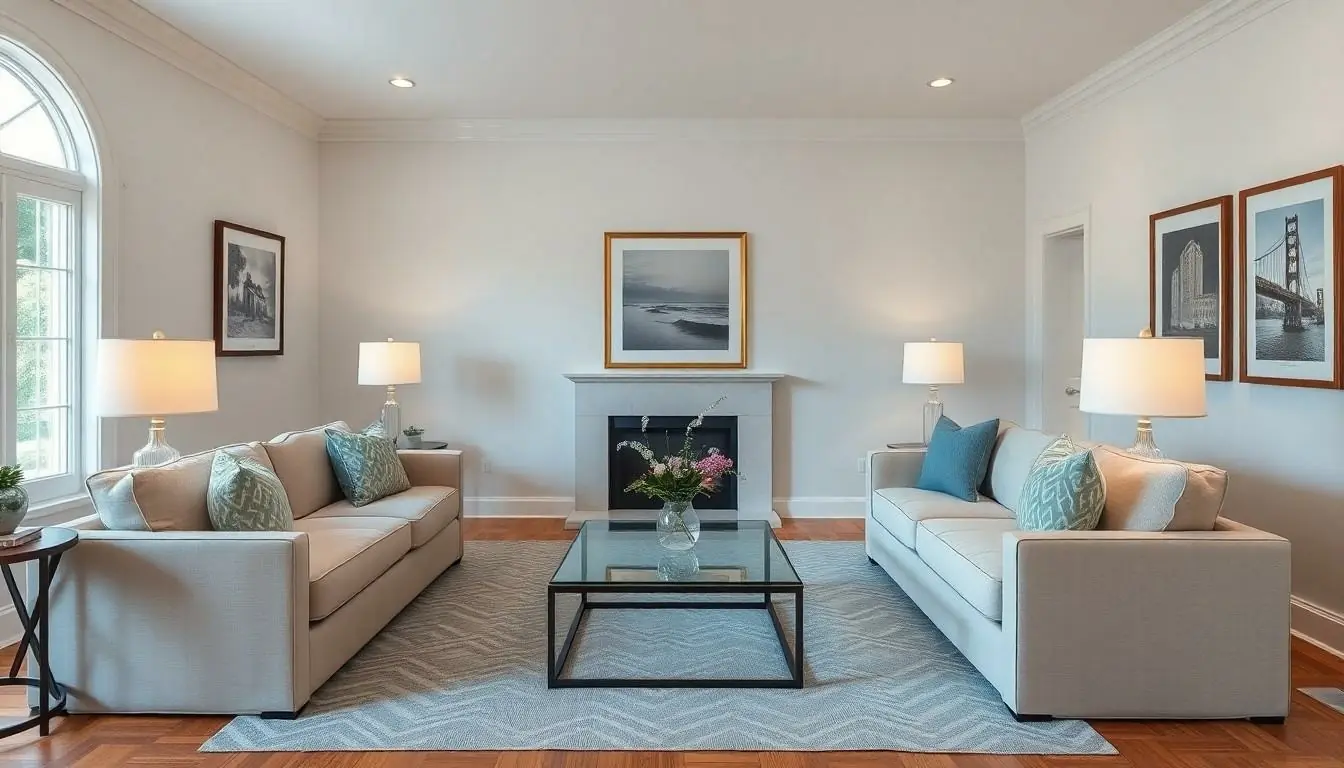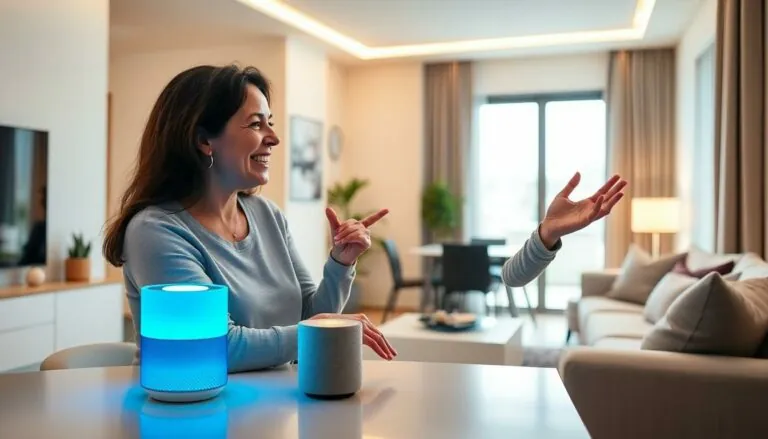In the world of interior design, symmetrical balance is like the peanut butter to your jelly—perfectly paired and undeniably satisfying. Imagine walking into a room where everything feels just right, as if the furniture and decor are in a harmonious dance. That’s the magic of symmetry! It creates a sense of order and calm that can turn even the most chaotic spaces into serene sanctuaries.
Table of Contents
ToggleUnderstanding Symmetrical Balance in Interior Design
Symmetrical balance creates harmony in interior design. This design principle promotes visual stability and enhances the overall aesthetic.
Definition of Symmetrical Balance
Symmetrical balance refers to the arrangement of elements in a design that mirror each other. It involves placing identical or similar items on opposite sides of a central axis. Examples include paired lamps flanking a sofa or matching artwork on either side of a fireplace. Designers strive for symmetry to foster a cohesive and orderly space. Such arrangements often evoke feelings of calmness and predictability.
Importance of Symmetry in Design
Symmetry plays a crucial role in creating visual harmony in interior spaces. A balanced layout directs attention and anchors the design. It enhances the attractiveness of a room by breaking down chaos. Common uses of symmetry include positioning furniture, selecting decor items, and organizing layouts. Spaces that utilize symmetrical balance often feel more welcoming and organized. Achieving this balance simplifies design choices, making it easier to create effective and appealing interiors.
Elements of Symmetrical Balance

Symmetrical balance incorporates several design elements that work together to create harmonious spaces. Understanding these elements enhances the effectiveness of interior design.
Furniture Arrangement
Furniture arrangement plays a crucial role in achieving symmetrical balance. Directly opposite seating, like matching sofas or chairs, establishes a visual anchor. Placing items equidistant from a focal point ensures coherence. For example, two identical armchairs flanking a coffee table can create a welcoming environment. Arranging larger pieces symmetrically also enhances flow, guiding movement through the space. Balanced layouts simplify navigation and foster comfort in areas like living rooms or dens.
Color Schemes
Color schemes significantly impact the perception of symmetrical balance. Consistent colors across mirrored elements produce visual unity. For instance, painting both sides of a space in a complementary hue promotes equilibrium. Using identical accent colors on paired furniture reinforces symmetry. Additionally, incorporating neutral tones for larger items allows bolder colors in accessories to stand out. Creating monochromatic schemes with varying shades can also enhance depth while maintaining balance. A well-planned color palette simplifies design choices and fosters a calming atmosphere.
Decorative Accessories
Decorative accessories deepen the effect of symmetrical balance within a space. Implementing identical items on either side of a central feature enhances visual interest. For example, using twin lamps on side tables creates a cohesive look. Artworks displayed symmetrically can draw the eye and frame a space effectively. Furthermore, matching vases or books adds layers without complicating the design. Thoughtfully placed accessories coordinate with larger furniture, reinforcing the overall aesthetic. Utilizing these elements effectively balances functionality with style.
Benefits of Symmetrical Balance in Interior Design
Symmetrical balance significantly enhances interior design through various benefits. This design principle invites visual appeal and contributes to inviting atmospheres.
Visual Harmony
Visual harmony emerges through the balanced look that symmetry creates. Arranging elements that mirror each other fosters an aesthetically pleasing environment. It simplifies choices by establishing clear lines and structured layouts. Complementing colors across mirrored objects strengthens the cohesive look. Guests often feel more at ease in spaces that showcase symmetry, promoting a sense of order.
Enhanced Functionality
Enhanced functionality is another advantage of symmetrical balance. Arranging furniture in a symmetrical manner optimizes flow within spaces, making them more practical. Many designers opt for paired seating to encourage conversation while maintaining balance. This layout supports movement, allowing for easy navigation throughout the room. By anchoring the design, symmetry also delineates purpose, providing clarity and efficiency in everyday living.
Psychological Impact
Symmetrical balance holds a significant psychological impact on occupants. People naturally gravitate toward environments that exhibit balance and order. Stability in design promotes relaxation and reduces feelings of chaos. Spaces showcasing symmetry often evoke comfort and tranquility, positively influencing mood. The design principle satisfies an innate desire for equilibrium, making spaces feel more inviting and secure.
Creating Symmetrical Balance in Your Space
Establishing symmetrical balance creates a visually appealing and harmonious environment. This design principle enhances the tranquility of a room through careful arrangement and selection of elements.
Tips for Achieving Balance
Choose furniture pieces that mirror each other, such as two identical sofas or armchairs. Position these on opposite sides of the room to establish a central focus. Select artwork and decor that reflects symmetry, like matching frames or dual lamps. Incorporate consistent color palettes across symmetrical elements to strengthen cohesion. Lastly, maintain symmetry in layout, ensuring equal space between elements to create a balanced flow.
Common Mistakes to Avoid
Overloading a space with too many identical items disrupts the intended balance. Ignoring scale can lead to disproportion, affecting the room’s appeal. Failing to consider appropriate spacing often results in cluttered designs. Neglecting natural light when placing elements may hamper the overall symmetry. Lastly, using mismatched colors detracts from the harmony, reducing the effectiveness of symmetry in the design.
Embracing symmetrical balance in interior design transforms spaces into harmonious retreats. By thoughtfully arranging elements to mirror each other, designers can create an inviting atmosphere that promotes tranquility and order. This balance not only enhances the visual appeal but also optimizes functionality, encouraging seamless movement and interaction.
Utilizing matching furniture, cohesive color schemes, and carefully selected accessories allows for a cohesive look that resonates with comfort. When executed correctly, symmetrical balance instills a sense of security and calm, making any environment feel more welcoming. Adopting these principles can lead to stunning interiors that reflect both style and serenity.





